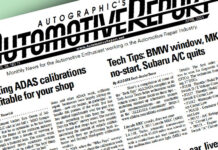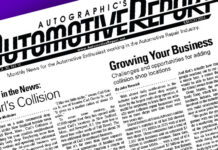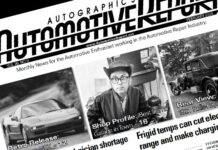Required vehicle safety checks, ADAS calibrations among new issues facing body shops
By John Yoswick
Over the past four or five years, vehicle scanning has become widely adopted as a necessary process within the collision industry. But the latest technical challenge are the variety of calibrations of advanced driver assistance systems required on a growing number of vehicles, and OEM requirements for some comprehensive safety checks that must be performed as part of the collision repair process.
Two board members of the Society of Collision Repair Specialists (SCRS) at a recent association meeting highlighted those post-accident safety inspections. Montana shop owner Bruce Halcro and Oregon shop owner Ron Reichen gave a presentation at an open SCRS board meeting that focused on the safety inspections that Subaru calls for after one of its vehicles has been in a collision.
“These are physical inspections, not something that’s included in a pre- or post-repair scan,” Reichen said. “They basically ask that you do some disassembly so you can visually look at cage nuts that are mounted in certain areas [such as seatbelt anchors], to see if there is any stretching or stress points, or if there’s any wiring that may have been pulled [in a way that could lead to] connection or connectivity issues, especially in supplemental restraint systems.”
The wiring may function well enough to get a clear scan, Reichen said, but if it is stretched, frayed or only partially connected, road vibration could lead it to fail, possibly leading to a failure of the airbag system.
“That’s why it’s so critical,” Reichen said.
Halcro agreed that some of the required inspections are “intense,” potentially requiring 15 to 20 labor hours.
“You’re actually pulling out the dash, and checking the wiring underneath the dash, the connectors,” Halcro said. “There’s a safety beam under there that we take photos of to document in the file that we inspected all that.”
Halcro’s and Reichen’s shops each have earned Subaru certification. They said Subaru’s online repair procedures include various checklists for the safety inspections based on the vehicle model, the area of the vehicle impacted, whether airbags deployed, etc.
Both shop owners said that because some Subaru dealers in their area do not have body shops, they have had to educate service advisors at those dealerships about the safety inspections that are part of the OEM collision repair procedures.
“Because they’re going to get called,” Halcro said. “The adjuster may talk to the dealer, and then tells us the dealer doesn’t know anything about it. A lot of times that’s true. They don’t know about it because they’re not doing collision repair.”
More than just Subaru
Mark Olson of VECO Experts said Subaru is not alone in calling for such physical safety inspections after a collision.
“This is General Motors, Fiat Chrysler. This is all cars,” Olson said.
He said he is aware of three lawsuits involving shops’ failure to conduct such inspections.
“You’re not going to hear about them because they’re going to settle out of court,” Olson said. “Those checklists are what the attorney is going to look at and say, ‘Did you do this, this and this?’ On some models, you have to remove and reinstall the headliner and the airbag, which is not reusable, so you actually have to deploy the airbag and replace it simply as part of the inspection.”
Olson and Reichen both said too few shops know about – let alone follow – the safety inspections called for by the automakers.
“I would [guess] that there’s probably less than 1 percent of repairers in the United States today that are even aware of a safety inspection that’s required after a collision,” Reichen said.
Olson said shop owners may only learn of those procedures after an automaker ducks a liability lawsuit because of a shop’s failure to conduct the inspections.
“The automaker is going to say, “Wait a minute. ABC Autobody ordered a bumper cover and a headlight for that vehicle. Here’s all the things they should have done,’” Olson said. “All of a sudden it’s right on your lap. You may think, ‘Oh, we’ve never had a problem.’ But all it takes is one.”
Halcro said that’s why his shop is performing the safety inspections.
“My take as the owner is: We’re not in the liability business. We’re in the repair business,” Halcro said. “We’re just not going to take on the liability of not repairing it properly.”
New types of calibrations
At a recent Collision Industry Conference (CIC), speakers highlighted some of the complexity the collision repair industry is facing in both “static” and “dynamic” calibrations of some advanced driver assistance systems.
Jack Rozint of Mitchell International and chairman of CIC’s “Emerging Technologies Committee,” said dynamic calibrations can require test driving the vehicle while connected to either an OEM scan tool or a specialized aftermarket scan tool.
“Basically, only [an OEM tool or] the very best of the aftermarket scan tools are capable of doing these routines,” Rozint said.
The calibrations may require that the vehicle maintains a certain speed for a set period. Road requirements can include a clear side line and center line on a straight road in the daylight. That can be a challenge in urban areas, Rozint said, noting he’s heard of shops trying to do these just as the sun comes up when there’s less traffic congestion.
“And if it’s snowing or foggy or raining, or if there’s been sand placed on the road that’s covering or obscuring the lines, it won’t work,” Rozint said. “If you get stopped half-way through, in some cases, depending on the vehicle and the scan tool, you might have to start all over again.”
Montana shop owner Matthew McDonnell, a member of the CIC committee, said such calibration test drives are becoming more common as more vehicles have lane-departure warnings and other such systems. He pointed to the requirements for the 2017 Ford F-150, which call for a 10-minute drive at 40 mph after any repair involving a windshield replacement, change in tire size, suspension repair or alignment, front airbag deployment or interior mirror replacement.
New types of static calibrations
While static calibrations, done in the shop rather than as part of a test drive, may seem more simple, Rozint said they can require very specialized targets and equipment. The ultrasonic blind spot radar in some newer Honda, Toyota and Kia vehicles, for example requires the use of a metal reflector cone, a laser and a goniometer jig, a device that measures angles. Some of the newest Audis, he said, include 360-degree cameras and Doppler devices to monitor what is going on around the entire vehicle in real time.
“To calibrate that, you need this aluminum structure with magnetic panels on it, and there are laser distance meters built into that,” Rozint said.
The BMW 7-series includes a pedestrian detection system that is based on body heat. It requires a pole-like target with a 98.6-degree device at the top that you place a set distance in front of the car to simulate a person as you use a scan tool to calibrate the system.
“So if you thought you were getting yourself positioned for some basic target calibrations and some dynamic drive calibrations, that’s great, but welcome to what’s coming this year and next year, with even more coming behind that,” Rozint said. “Those who aren’t training in this area may want to consider doing so.”
He cautioned that subletting this work to dealers may not alleviate the need for shops understand what those dealers need to be doing.
“In some cases, they’ve never done it before themselves,” Rozint said of some dealers. “So if you don’t have the training yourself, you may not even be able to properly identify someone who is qualified to do it.”
Following the presentation at CIC, Ray Fisher, executive director of the Automotive Service Association (ASA), urged the industry to consider safety when conducting dynamic calibrations on the road.
“When technicians go on a test drive with a scan tool, they are at risk. That is ‘distracted driving,’” Fisher said. “So I really encourage shop owners to protect your technicians. Realistically [such test drives] may require two people.” •
John Yoswick, a freelance writer based in Portland, Ore., who has been writing about the automotive industry since 1988, is also the editor of the weekly CRASH Network (http://www.CrashNetwork.com). He can be contacted by email at john@CrashNetwork.com.



